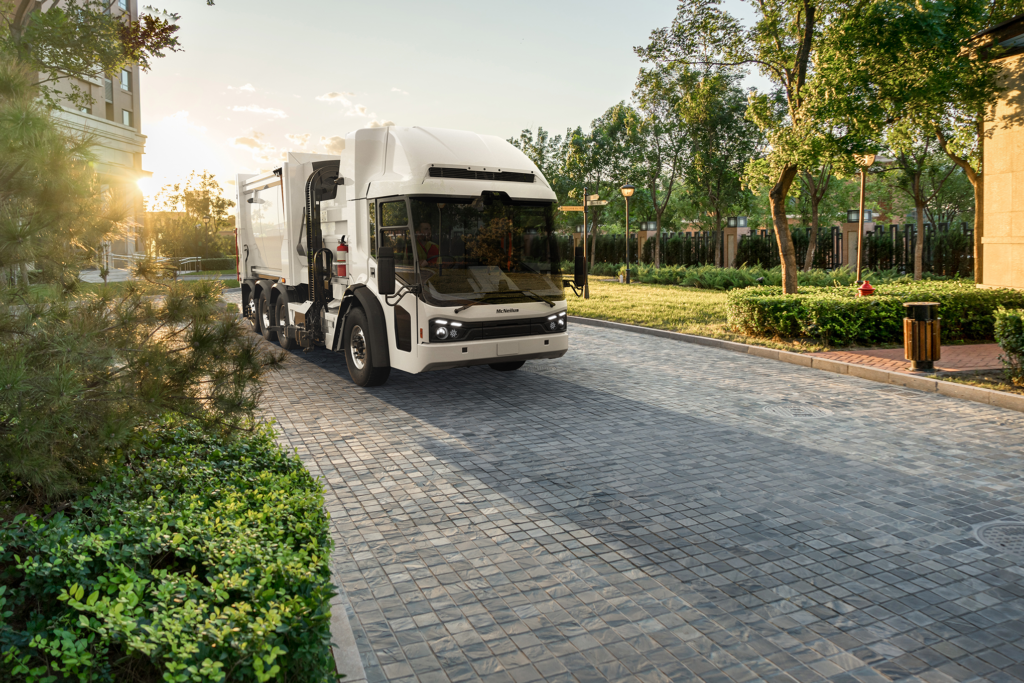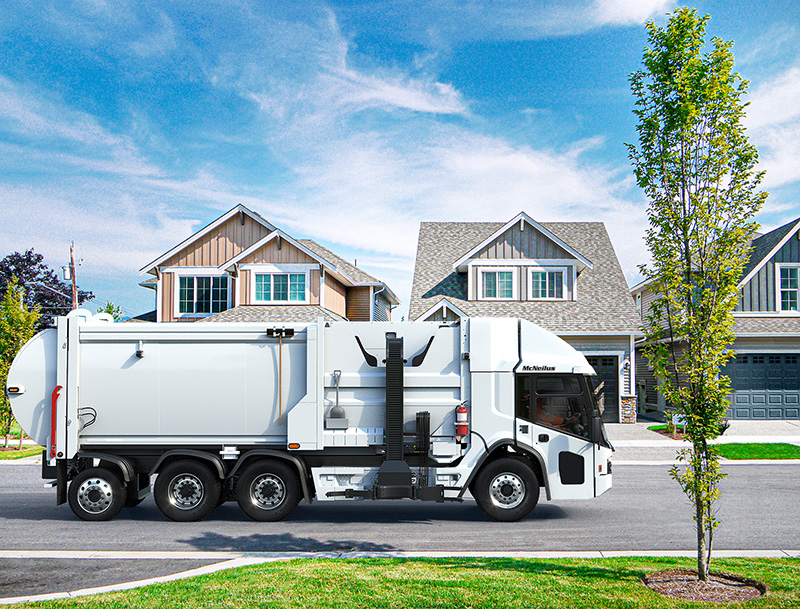Sponsored by:
Over the past five years, electric vehicles (EVs) have undergone a remarkable transformation, propelling them from niche alternatives to mainstream transportation options. Passenger cars have led the way, but heavy duty vehicles and task-specific vehicles are making important technological gains. The waste management industry is seeing significant advancements with electric refuse collection vehicles (eRCVs). The recent introduction of the McNeilus® Volterra™ ZSL™ fully integrated, zero-emission refuse collection vehicle and the McNeilus® ePTO self-contained, advanced electric power takeoff system are the most recent examples of eRCV technology in the industry.
Here, we dive into the advantages of eRCVs, along with the challenges and concerns faced by EV customers, and we explore the promising future that lies ahead for electric severe-duty vehicles.
Advantages of Electric Refuse Collection Vehicles
The rise of eRCVs represents a pivotal shift in the waste management landscape. These vehicles offer a multitude of anticipated advantages that extend beyond the confines of the industry, positively influencing the environment and society at large. Let’s take a closer look at some of the benefits.
Noise Management: Refuse collection typically occurs during early morning hours, and the rumble of refuse collection with ICE vehicles can disrupt neighborhoods. In a 2019 CBS News report from the Chicago area, the number one complaint related to refuse collection was early morning noise. Electric refuse collection vehicles operate with low noise levels, helping contribute to quiet urban and suburban environments.
Cost Considerations: While the initial investment in eRCVs may be higher compared to their ICE counterparts, the potential savings in total cost of ownership (TCO) can be substantial. Electric vehicles generally have less moving parts, which can help minimize maintenance and repairs. The cost difference between electricity and diesel fuel or compressed natural gas is also a factor that has potential to lower operational expenses over the vehicle’s lifespan.
Environmental Responsibility: Unlike more traditional internal combustion engine (ICE) vehicles, electric power produces zero emissions in use, which can help mitigate air pollution from greenhouse gasses. This helps contribute to local Clean City initiatives, clean air quality, healthy communities, and a manageable carbon footprint. Additionally, by embracing eRCVs and other sustainability measures, waste management companies can extend their position as forward-thinking and demonstrate their commitment to environmentally responsibility. This may help lead to positive public perception, customer loyalty and potential partnerships with eco-conscious companies and organizations.
Technological Advancements: From where electric technology was five years ago, EVs have become more efficient and capable of traveling longer distances on a single charge. Improvements in battery technology, such as the widespread adoption of lithium-ion batteries, have significantly increased energy density, charging speeds and overall driving range. In addition, EV manufacturers have been actively improving and refining powertrain systems. These advancements have resulted in improvements that have made some powertrain systems comparable to conventional ICE vehicles for performance.
The advanced state of technology is also evident in task-specific vehicles such as the McNeilus Volterra ZSL refuse vehicle. The purpose-built eRCV can complete a full refuse collection route on a single charge and can quietly and efficiently perform the daily task of refuse collection with zero emissions. Its collaborative regenerative braking system can recharge the batteries while adjusting to battery state of charge and road conditions, extending brake life and route capability.
Challenges with Electric Refuse Collection
While eRCVs present an array of benefits, their adoption has not been without challenges and concerns. Many of these concerns have been mitigated by technological advancements or through close coordination between manufacturers and waste management companies. Let’s look at how some of these challenges are currently being addressed.
Range Limitations: Because operational range is determined by battery capacity, waste management companies may have concerns about route planning and scheduling with electric refuse collection vehicles. Advanced battery technology and innovations such as cooperative regenerative braking systems can extend the eRCVs operating range. For example, the McNeilus Volterra ZSL eRCV has sufficient range to complete a wide variety of collection routes on a single charge. Waste management companies may need to consider factors such as number of routes and route type when adding electric vehicles to their fleets.
Charging Infrastructure: For some, another concern with eRCVs is the need for a charging infrastructure. It’s essential to develop plans for charging stations to accommodate eRCV fleets, and ensure they have sufficient power to complete specific routes. As passenger EVs have been hampered at times by the sparsity of extensive charging infrastructure, fleets comprised of refuse collection vehicles have the advantage of returning to the same location at the end of their workday. This enables eRCV fleets to use a charging system that can be maximized for operational costs and built for resiliency.
Over the past few years, the design of electric microgrids has provided EV owners the ability to charge their vehicles with electricity they have generated and stored in case electric service is disrupted locally. Even when using existing power systems and infrastructure, customers should consider their electricity usage structure, including duration and peak usage, as well as fleet size, amount of available power and quantity and capacity of charging stations needed.
EV Investment: While the initial investment in electric vehicles and charging infrastructure can be significant, it can be offset by long-term savings in operation and maintenance costs, operational efficiences and by financial incentives provided by governmental agencies where available. Governments and regulatory bodies may offer additional incentives and subsidies to encourage the adoption of zero-emission vehicles, including incentives for developing private charging infrastructure systems.
Battery Life and Replacement: The longevity of batteries for eRCVs, as with passenger EVs, has also been a concern with some customers. Battery degradation over time could have a major impact on financial considerations for eRCVs, but battery technology has improved dramatically over the past few years. Battery and eRCV manufacturers may offer extended warranties to provide cost assurance for customers.
Training and Maintenance: Training maintenance staff to properly operate and maintain eRCVs is essential. Manufacturers will be expected to help provide specialized training programs for customers to ensure they are equipped with the necessary skills and knowledge to maintain their fleets.
Total Cost of Ownership: As adoption of EVs increases, and as the technology becomes more sophisticated, operators of EV fleets may see a reduction in cost. There are distinct advantages in total cost of ownership for EVs when taking into consideration the potential for cost reduction and other factors such as maintenance and fuel costs, longevity and governmental incentive plans. TCO considerations for eRCVs are top of mind with customers and by working with a well-established and experienced manufacturer and purchasing the most advanced eRCVs available they will have a clear understanding as they plan their transition to a zero-emission fleet.
Looking Ahead
In the near term, the future of EVs appears promising. Challenges are being met with advanced technology solutions. We are already seeing advancements with battery technology such as increased driving range and faster, more convenient charging options. And below are a few more areas of opportunity for EVs.
Regulatory Environment: The regulatory environment is driving much of the transition to alternative power sources, specifically electric. The California Air Resource Board (CARB) has established a zero-emission vehicle (ZEV) requirement that truck and bus fleets be zero emissions by 2045, and fourteen other states are considering adopting California’s ZEV requirements. They are Colorado, Connecticut, Maine, Maryland, Massachusetts, Minnesota, New Jersey, Nevada, New Mexico, New York, Oregon, Rhode Island, Vermont, Virginia, and Washington. All signs point to an increase in the number of states requiring zero-emission fleets. Balancing the regulatory requirements and financial incentives will continue to be part of the planning process for fleets looking to transition to electric vehicles. Working with a manufacturer who knows the refuse collection industry and has expertise in EV technology is a key component.
Collaborative Partnerships: Some waste management companies have begun to develop partnerships with manufacturers and component suppliers. Partnerships with eRCV manufacturers can include innovative service and training programs to help ensure that operation and maintenance of eRCVs is a collaborative and streamlined effort.
Integrating Smart Technology: eRCVs are likely to become increasingly integrated with smart technology and data analytics. Real-time monitoring, condition-based maintenance, advanced driver assist systems and real-time route readiness monitoring can help enhance operational efficiency and reduce downtime.
Conclusion
The emergence of eRCVs marks a significant turning point in the waste management industry’s journey toward sustainability and environmental responsibility, and the global adoption of EVs is accelerating. This is being driven by a desire to see positive environmental change and reduce reliance on fossil fuel, which can increase energy independence and economic stability.
Every indication is that the political and regulatory environment will continue to create incentives for transitioning to alternative power for refuse collection vehicles and other heavy duty vehicles. Complying with state requirements and taking advantage of government incentives will continue to be a major consideration in fleet management. Electric refuse collection vehicles will not be the sole answer to reaching zero emission requirements but will definitely be part of the solution.
The advances in eRCV technology are beginning to propel the industry forward to a brighter and cleaner future. The initial challenges that hindered the transition to eRCVs are being replaced with technological advancements, incentives and policies designed to support EV adoption within the refuse industry. The way electric technology continues to evolve, along with other alternative fuel sources, will continue to shape the transition to zero emission refuse collection vehicles. As we look ahead one thing is certain: the waste management landscape is advancing farther and faster than anyone would have guessed just a few years ago.
For more information email: [email protected]




